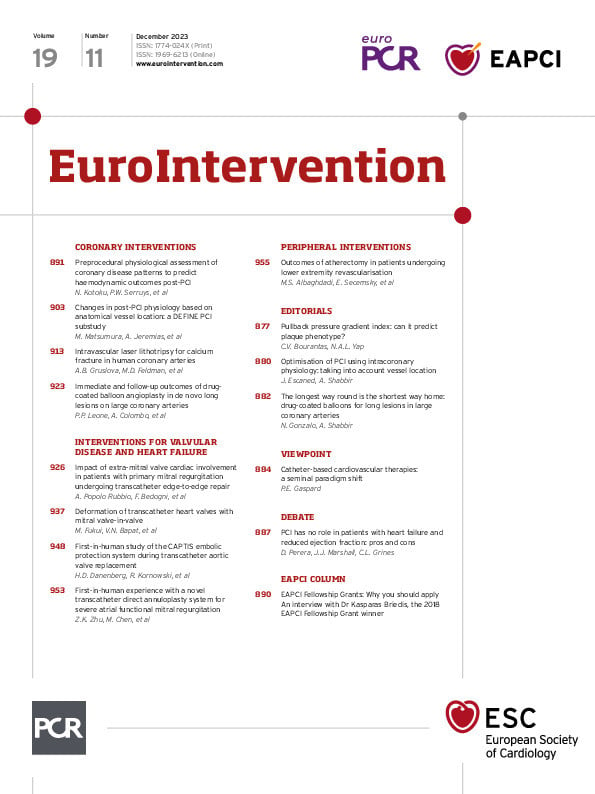The arc of intracoronary physiology bends towards the guidance of percutaneous coronary interventions (PCI). Over the last 45 years, the use of intracoronary pressure measurements has shifted from gauging the results of balloon angioplasty to establishing the functional relevance of coronary stenoses as a prerequisite to consider PCI, and now, as highlighted in a recent European Association of Percutaneous Cardiovascular Interventions (EAPCI) Clinical Consensus Document1, has gone back to planning and guiding PCI.
Why this interest? In a nutshell, since a suboptimal functional PCI result is associated with worse long-term outcomes, an assessment with fractional flow reserve (FFR) or instantaneous wave-free ratio (iFR) should be considered once a good procedural angiographic result has been obtained. Whenever post-PCI iFR or FFR values are overtly abnormal, establishing the cause and the feasibility of procedural optimisation should be considered. What is currently a matter of discussion are the optimal FFR/iFR cutoff values that should define a suboptimal functional PCI result and should trigger PCI optimisation.
In this context, in this issue of EuroIntervention, Matsumura et al2 report on a subanalysis of DEFINE PCI, one of the pivotal studies in establishing the incidence and mechanisms of abnormal physiology values after angiographically successful PCI3. In previous reports, the DEFINE PCI study revealed that functional PCI results are frequently suboptimal despite a good angiographic result3, and that a post-PCI iFR ≤0.94 predicts 1-year cardiac events3. The focus of the current substudy was the impact of vessel location on post-PCI iFR measurements. For this, the investigators first reviewed the post-PCI iFR pullbacks that were blindly obtained during the study and categorised iFR gradients according to their location (distal to the stent; in-stent, including 5 mm proximal and distal margins; and proximal to the stent). Then, they classified iFR gradients as reflecting the existence of focal or diffuse obstructive disease. Finally, they performed a comparison between left anterior descending (LAD) and non-LAD vessels in terms of pre- and post-PCI physiology.
The investigators found that absolute post-PCI iFR values are lower in LAD than in non-LAD vessels. This is in agreement with previous studies referenced in the article and also with a recently published large individual patient analysis (n=3,336 vessels) showing that post-PCI FFR is, on average, 0.06 FFR points lower in LAD than in other vessels4. What the DEFINE PCI subanalysis adds to existing knowledge is that a focal iFR pressure drop at the stented site occurs more frequently in the LAD than in other vessels; this finding that may be related to a combination of more challenging plaque characteristics − causing lower minimal stent area, smaller vessel diameter and higher flow in the LAD than in other vessels treated with PCI − and to the hydrostatic effect of LAD height in patients in a supine position5. Since intracoronary imaging was not used per protocol in the DEFINE PCI study, we cannot assess to what degree these factors played a role in the focal iFR loss noted in stented LAD lesions. The fact that both iFR and FFR values are lower in the LAD after PCI confirms that this phenomenon affects both resting and hyperaemic indices, ruling out the possibility of a selective effect of resting indices. Another relevant finding of the study is that, irrespective of the vessel treated, the success of PCI in relieving angina mirrored post-PCI iFR values. Again, these findings are confirmatory of findings in other studies like Target-FFR6.
A practical take-home message of this study is that the singularities of pressure guidewire interrogation in the LAD should be taken into account during physiology-based PCI guidance and that lower postprocedural FFR/iFR values must be expected and integrated into the decision-making process. The location of the physiological assessment is therefore an important factor when interpreting post-PCI FFR/iFR. As emphasised in the EAPCI Consensus Document, overreacting to abnormal postprocedural FFR/iFR values must be avoided, and aggressive post-dilation or additional stenting should be avoided until clarifying what has caused the abnormal values and establishing whether such a cause would be amenable to additional optimisation manoeuvres1. Given the current interest in the topic of physiology-guided PCI, further research in this field is expected.
Conflict of interest statement
The authors have no conflicts of interest to declare.

